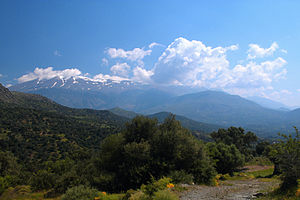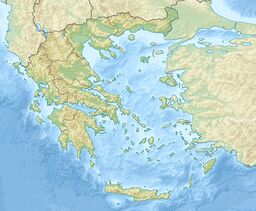Mount Ida (Crete)
Topic: Religion
 From HandWiki - Reading time: 5 min
From HandWiki - Reading time: 5 min
| Mount Ida | |
|---|---|
| Psiloritis (summit Ida) | |
 View of Psiloritis mountains from the west | |
| Highest point | |
| Elevation | 2,456 m (8,058 ft) [1] |
| Prominence | 2,456 m (8,058 ft) [2] |
| Listing | Ultra |
| Coordinates | [ ⚑ ] : 35°13′36″N 24°46′21″E / 35.22667°N 24.7725°E [2] |
| Geography | |
| Location | Crete, Greece |
Mount Ida (Greek: Ἴδα),[3][4] known variously as Idha, Ídhi, Idi, and Ita (the massif including the mountain is called Psiloritis, Greek: Ψηλορείτης),[5] is the highest mountain on the island of Crete, with an elevation of 2,456 metres (8,058 ft). It has the highest topographic prominence of any mountain in Greece.[2][6] A natural park which includes Mount Ida is a member of UNESCO's Global Geoparks Network.
Located in the Rethymno regional unit, Ida was sacred to the Titaness Rhea in Greek mythology. On its slopes lies one of the caves, Idaion Antron, the Idaean Cave, in which, according to legend, the god Zeus was born. Other legends, however, place his birthplace in Psychro Cave on the Lasithi Plateau.
An archaeobotanical study was conducted that looks at the different plant bases in Minoan villas during the Neo-palatial time period in Crete. There was a rich range of food plants that were found to contain essential nutrients such as carbohydrates, protein and sources of vitamins.[7] The study took place on Mount Ida, at the Minoan villa of Zominthos.
Features
The Psiloritis is located on the water divide between the southern part of Crete, which drains to the Libyan Sea, and the northern basin facing the Aegean Sea. A saddle at 2,321 m East of the summit connects it with Mount Agathias,[1] while westwards the ridge continues with Mount Stolistra (2,336 m)[8]
The Skinakas Observatory of the University of Crete is located on the secondary peak Skinakas at 1750 m. It has two telescopes including a 1.3 m Modified Ritchey-Chrétien instrument.[9][10]
The Nida plateau is found to the east of the mountain.[11] On the plateau are some shepherd's huts (mitata) built only of local stones, and used both for shelter and for cheesemaking.[12][13][14] On the northeast of the mountain, beneath Skinakas Peak, the site of the observatory, is Vromonero Plateau, the site of a holly and maple grove, with many endemic and endangered species. It, along with the access road through Halasia Gorge, and the starting point at Krousonas, has been defined as a Natura 2000 protected area[Note 1]
Zominthos is a plateau that is located in the northern foothills of Mount Ida. On the plateau is the highest altitude Minoan villa ever found, the Minoan villa of Zominthos.[7]
The Kamares Cave is an Ancient Greek sanctuary located on Mount Ida. During the excavation of the cave, numerous pieces of pottery, like vases, were found in the cave. Based on the condition and pattern of the vases, it is known that the pieces of pottery were crafted by peasants at the time. Typically, Cretan pottery is known to have a polychrome ornament, and a black base. The Kamares Cave was not fully excavated however until 1913. The findings gave real insight into Ancient Greek life in relation to Mount Ida.[15]
Mythology
Dactyls
Ida is the locus for a race of legendary ancient metal workers, the Dactyls.
Idaean Cave
In ancient times the Idaean cave, "cave of the Goddess" (Dea) was venerated by Minoans and Hellenes alike. By Greek times the cave was rededicated to Zeus.[16] The cave where Zeus was nurtured is variously stated to be this cave, or another of the same name, or the Dictaean cave.[17]
Votive seals and ivories have been found in the cave.[18] Like the Dictaean cave, the Idaean cave was known as a place of initiations.[19] It may have served as the site of an oracle, symbolized by the frequent depiction of a tripod on coins of nearby Axos, which presumably controlled the territory around the cave.[20]
The Old Man of Crete
Dante in Inferno XIV visualized an old man within Mt. Ida. His head was of gold, his arms and breast of silver, his lower abdomen brass, and below that he was of iron except that his right foot was of clay, upon which all his weight bore. This symbolized the decay of the world, and his tears formed the rivers of Hell.[21]
Gallery
See also
- Idaea
- Mount Kedros
- List of mountains in Greece
References
- ↑ 1.0 1.1 "Mount Ida, Greece". http://www.peakbagger.com/peak.aspx?pid=10370.
- ↑ 2.0 2.1 2.2 "Europe Ultra-Prominences". Peakbagger.org. http://www.peaklist.org/WWlists/ultras/EuroCoreP1500m.html.
- ↑ Verse 332 of the act B, of the bucolic drama Πανώρια by the 16th century Cretan writer Γεωργίος Χορτάτσης: «Ἐγὼ δὲ θὲ νὰ παντρευτῶ καὶ βρὲ ἄλλη κορασίδα, ἀπ’ ὄμορφες ἀρίφνητες ἁπού ‘ν’ ἐπὰ εις τὴν Ἴδα˙» (The tomonym is mentioned several times in this work.)
- ↑ Summit Ida in the center of the map, by Marco Boschini, 17th century Venice. Item (GE C-8841) National Library of France.
- ↑ Psiloritis in the center of the map, by Abraham Ortelius, 1598 Antwerp, from Archipelagi Insularum Aliquot Descrip.
- ↑ Topo25 Hiking Map of Mt IDHA (2006 edition)
- ↑ 7.0 7.1 Livarda, Alexandra; Kotzamani, Georgia (2020-09-16). "Plant resources and subsistence in the Late Minoan mountain 'villa' at Zominthos, Crete" (in en). Archaeological and Anthropological Sciences 12 (10): 237. doi:10.1007/s12520-020-01203-1. ISSN 1866-9565. https://doi.org/10.1007/s12520-020-01203-1.
- ↑ 1:35.000 scale map nr.11.14 - Ψηλορείτης (Agathias) (Map). Anavasi.
- ↑ "Skinakas Observatory". University of Crete Department of Physics. http://www.physics.uoc.gr/en/node/62.
- ↑ "Skinakas Observatory". Skinakas Observatory. http://skinakas.physics.uoc.gr/en/.
- ↑ "Introducing Mt Psiloritis". Lonely Planet. http://www.lonelyplanet.com/greece/mt-psiloritis/introduction.
- ↑ Antonis Plymakis, Koúmoi-Mitáta kai Boskoi sta Leuká Ori kai Psiloriti ("Shepherd's huts and shepherds in the Lefka Ori and the Psiloritis"), Chania, 2008, 630 p.
- ↑ Harriet Blitzer, Pastoral Life in the Mountains of Crete. An Ethnoarchaelogical Perspective, in Expedition, vol. 32, No 3, 1990, pp. 34-41 (on the shepherd's huts of Eastern Crete.
- ↑ Sabine Ivanovas, Where Zeus Became a Man (with Cretan Shepherds), Efsthiadis Group Editions, 2000, 183 p. (Life in the corbelled dry stone huts of central Crete).
- ↑ Dawkins, R. M.; Laistner, M. L. W. (November 1913). "The Excavation of the Kamares Cave in Crete" (in en). Annual of the British School at Athens 19: 1–34. doi:10.1017/S0068245400009060. ISSN 2045-2403. https://www.cambridge.org/core/journals/annual-of-the-british-school-at-athens/article/abs/excavation-of-the-kamares-cave-in-crete/DB63F3F6FAC8660F596634505E138965#.
- ↑ Diodorus Siculus, V.70.
- ↑ William Smith, ed (c. 1873). A Dictionary of Greek and Roman biography and mythology. John Murray. https://www.perseus.tufts.edu/hopper/text?doc=Perseus%3Atext%3A1999.04.0104%3Aalphabetic+letter%3DZ%3Aentry+group%3D2%3Aentry%3Dzeus-bio-1.
- ↑ J. Lesley Fitton,Ivory in Greece and the Eastern Mediterranean from the Bronze Age to the Hellenistic Period (British Museum. Dept. of Greek and Roman Antiquities),1992
- ↑ Yulia Ustinova, Caves and the Ancient Greek Mind: descending underground in the search for Ultimate Truth 2009:180.
- ↑ Ustinova, noting Capdeville 1990, and, critically, Prent 2005:568.
- ↑ The Symbolic Figure of the Course of Human History Described by Virgil. 1824-27
Notes
- ↑ Krousonas – Vromonero Idis, ID GR4310009. Natura 2000 Viewer
External links
 |
 KSF
KSF





